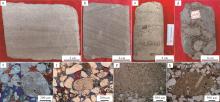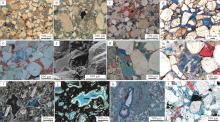

石油与天然气地质 ›› 2022, Vol. 43 ›› Issue (3): 514-527.doi: 10.11743/ogg20220303
朱世发1,2( ), 贾业2,3, 马立驰4, 崔殿4, 景安语4, 佟欢1,2
), 贾业2,3, 马立驰4, 崔殿4, 景安语4, 佟欢1,2
收稿日期:2021-04-27
修回日期:2022-03-09
出版日期:2022-06-01
发布日期:2022-05-06
第一作者简介:朱世发(1982—),男,博士、教授、博士生导师,沉积学和储层地质学。E?mail: 基金项目:
Shifa Zhu1,2( ), Ye Jia2,3, Lichi Ma4, Dian Cui4, Anyu Jing4, Huan Tong1,2
), Ye Jia2,3, Lichi Ma4, Dian Cui4, Anyu Jing4, Huan Tong1,2
Received:2021-04-27
Revised:2022-03-09
Online:2022-06-01
Published:2022-05-06
摘要:
以渤海湾盆地济阳坳陷中生界为研究对象,利用岩心、薄片和分析化验等资料,研究风化壳储层的复杂岩性特征、成岩作用类型和储集空间特征,分析风化壳储层质量控制因素,建立多元控储模型,为济阳坳陷乃至中国陆相含油气盆地风化壳储层勘探与开发提供地质依据。研究表明:济阳坳陷中生界风化壳储集层发育陆源碎屑岩、火山碎屑岩、火山熔岩、次火山岩和深成侵入岩等5大类12小类岩石类型。初始孔隙度较高的碎屑岩储层质量最佳。大气淡水和有机酸的溶蚀作用明显改善碎屑岩储层;气体逸散、冷凝收缩、高温熔蚀以及酸性水溶蚀对火成岩储层有建设性意义。碎屑岩储层受岩石成熟度、压实强度、早期方解石胶结和二次埋藏有机酸改造的影响显著。次生溶蚀孔是主要的储集空间类型。济阳坳陷中生界风化壳储层质量受到岩性岩相、成岩流体、构造演化及现今埋深等多个因素的综合影响,提出了五元控储模型;建立了中生界储层甜点发育模型,将有利储层分为5类:断层和不整合面窗口溶蚀带、胶结残留淋滤带、剥蚀残留淋滤带、混合溶蚀带和有利岩相对接带。
中图分类号:
表1
渤海湾盆地济阳坳陷中生界复杂岩性潜山储层综合分类"
| 结构大类 | 成分大类 | 基本岩石类型 | 识别标志 | 代表井 | 对应层段 | |
|---|---|---|---|---|---|---|
陆源碎屑岩 (压实固结和水化学物胶结) | 碎屑结构 | 陆源碎屑物质 | 砾岩 | 常见于冲积扇、辫状河和辫状河三角洲河床底部滞留沉积,砾石常呈定向排列;冲积扇砾岩中泥砾常见,多为撕裂屑;中性凝灰质为杂基或岩屑 | 孤南40、富9 | 西洼组 |
| 孤北107 | 蒙阴组 | |||||
| 高41、高41-1 | 西洼组、 蒙阴组 | |||||
| (杂)砂岩 | 冲积扇:岩石分选、磨圆差,不明显的交错层理、块状层理发育,镜下为杂基支撑,磨圆差,面孔率低; 辫状河:砂体平面上带状分布,分流河道、分流河道间沉积发育,具有洪泛性越岸沉积组合,薄片下分选中等,颗粒呈次棱角状-次圆状; 辫状河三角洲:岩石分选较好,平行层理、板状、槽状交错层理发育,常见冲刷面构造 | 桩33、桩205、富9 | 西洼组 | |||
| 桩古35、桩107-1、 孤北33 | 蒙阴组 | |||||
| 高41、高56 | 西洼组、 蒙阴组 | |||||
| 桩181、桩斜208、 桩古22、胜海8、 埕北301、孤南31 | 三台组 | |||||
| 埕北306 | 蒙阴组、 三台组 | |||||
| 粉砂岩 | 发育于辫状河的分流河道间、辫状河三角洲前缘的支流间湾;孤西潜山带样品中含有凝灰质 | 垦古55 | 坊子组 | |||
| 高41、高41-1、高56 | 西洼组 蒙阴组 | |||||
火山熔岩 (基质中分布的火山碎屑含量<10 %, 冷凝固结) | 熔岩结构 | 中性 (SiO2 52 %~63 %) | 安山岩 | 斑状结构,气孔被后期充填具杏仁构造;斑晶矿物有辉石、角闪石、黑云母、斜长石,斜长石呈自形宽板状 | 富111、孤南41、 高41、桩98、桩22、 桩斜22、老30 | 西洼组 |
基性 (SiO2 45 %~52 %) | 玄武岩 | 矿物组成包括中、基性斜长石、角闪石、黑云母、辉石,具自碎角砾结构 | 富117、富121、高56 | 西洼组 | ||
| 自碎角砾 结构 | 各成分均可形成 | 自碎角砾熔岩 | 矿物组成包括中性斜长石、角闪石、黑云母、辉石,具自碎角砾结构 | 孤南217、富111 | 西洼组 | |
火山碎屑岩 (火山碎屑含量>90 %, 压实固结) | 火山碎屑 结构 | 中性 (SiO2 52 %~63 %) | 凝灰岩 | 超过半数粒径小于2 mm,部分可见层理,具有凝灰结构;矿物包括中、基性斜长石、角闪石、黑云母、辉石 | 孤南40、富121、 高41、高41-1、 高56、桩斜22 | 西洼组 |
火山 角砾岩 | 由大于2 mm的火山角砾组成,分选很差,呈棱角状 | 孤南40、富121、 桩古35、桩斜22、老30 | 西洼组 | |||
次火山岩 (冷凝固结) | 结晶结构 | 暗色脉岩类 | 煌斑岩 | 富含云母,暗色矿物含量高,具有煌斑结构;六边形角闪石斑晶直径几十微米,自形程度高 | 孤南26、富29 | 西洼组 |
| 浅色脉岩类 | 闪长玢岩 | 灰白色,半自形粒状,斑状结构,斑晶为斜长石,矿物成分包括斜长石、碱性长石、黑云母、石英;斜长石半径颗粒自形程度高,直径可达几十微米 | 孤北古1 | 三台组 | ||
| 孤南138、富291 | 西洼组 | |||||
| 隐爆角砾 结构 | 脉岩类成分 | 隐爆 角砾岩 | 隐爆角砾结构,岩石原地破碎,角砾边缘呈棱角状,具有可拼合性,角砾间缝隙被后期热液充填 | 孤南217,富29 | 西洼组 | |
侵入岩 (冷凝固结) | 辉长结构、 辉绿结构 | 基性 (SiO2 45 %~52 %) | 辉长岩 | 辉石颗粒粗大、自形程度高,位于长石构成的三角形格架中 | 高41、高41-1、高56 | 西洼组 |

图3
渤海湾盆地济阳坳陷不同地区中生界碎屑岩储层典型岩心和薄片照片a.辫状河三角洲平行和楔状交错层理砂岩,高41井,埋深1 267.20 m,西洼组,岩心; b.辫状河三角洲楔状交错层理砂岩,高41-1井,埋深1 313.20 m,西洼组,岩心; c.辫状河三角洲递变层理砾岩,桩181井,埋深3 110.50 m,蒙阴组,岩心; d.冲积扇砾岩,富9井,埋深2 702.80 m,西洼组,岩心; e.钙质砂岩,高41井,埋深1 290.50 m,西洼组,茜素红染色铸体薄片(-); f.中砂岩,桩181井,埋深3 110.50 m,三台组,茜素红染色铸体薄片(-); g.冲积扇砾石,方解石交代强烈,富9井,埋深2 701.72 m,西洼组,茜素红染色铸体薄片(-); h.冲积扇砾石中火山岩岩屑,孤北191井,埋深3 157.90 m,蒙阴组,茜素红染色铸体薄片(-)"


图4
渤海湾盆地济阳坳陷不同地区中生界火成岩储层典型岩心和薄片照片a.气孔杏仁状安山岩,老30井,埋深3 243.80 m,西洼组,岩心; b.火山角砾岩,老30井,埋深3 554.00 m,西洼组,岩心; c.闪长玢岩,孤古19井,埋深2 477.65 m,西洼组,岩心; d.玄武岩,孤南217井,埋深3 533.50 m,西洼组,普通薄片(-); e.煌斑岩,富291井,埋深3 116.00 m,西洼组,普通薄片(-); f.气孔安山岩,富29井,3 327.80 m,西洼组,茜素红染色铸体薄片(-); g.火山角砾岩,孤南40井,埋深2 354.30 m,三台组,茜素红染色铸体薄片(-); h.闪长玢岩,孤古19井,埋深2 477.50 m,西洼组,茜素红染色铸体薄片(-)"


图6
渤海湾盆地济阳坳陷中生界不同岩性储层中典型成岩作用a.安山岩中的原生气孔,老30井,埋深3 418.60 m,西洼组,茜素红染色铸体薄片(-); b.闪长玢岩熔蚀孔,富291井,埋深3 116.00 m,西洼组,茜素红染色铸体薄片(-); c.安山岩中硅质杏仁体收缩缝,富29井,埋深3 332.49 m,西洼组,铸体薄片(-); d.塑性颗粒变形,岩屑砂岩,桩181井,埋深3 027.90 m,三台组,茜素红染色铸体薄片(-); e.早期方解石胶结,长石质岩屑砂岩,孤北33井,埋深3 245.60 m,蒙阴组,茜素红染色铸体薄片(-); f.后期铁方解石胶结,长石砂岩,高56井,埋深928.64 m,西洼组,茜素红染色铸体薄片(-); g.多期方解石胶结,长石岩屑质石英砂岩,高41-1井,埋深1 317.40 m,西洼组,阴极发光;h.石英次生加大,石英砂岩,桩古35井,埋深3 435.55 m,蒙阴组,普通薄片(-);i.自生高岭石,长石岩屑质石英砂岩,高41井,埋深1 290.50 m,蒙阴组,扫描电镜;j.残余绿泥石,岩屑砂岩,高56井,埋深944.90 m,西洼组,茜素红染色铸体薄片(-); k.绿泥石和方解石交代长石,火山碎屑岩,孤南31井,埋深2 425.76 m,三台组,茜素红染色铸体薄片(-); l.方解石胶结物白云石化,埕北301井,埋深2 965.40 m,三台组,茜素红染色铸体薄片(-); m.岩屑溶蚀,岩屑砂岩,孤北191井,埋深3 157.90 m,蒙阴组,茜素红染色铸体薄片(-); n.长石的溶蚀作用,长石砂岩,孤北33井,埋深3 246.10 m,蒙阴组,茜素红染色铸体薄片(-); o.基质的溶蚀作用,闪长玢岩,孤古19井,埋深2 477.50 m,西洼组,茜素红染色铸体薄片(-); p.斑晶的溶蚀作用,安山岩,富121井,埋深3 615.40 m,西洼组,茜素红染色铸体薄片(-)"


图8
渤海湾盆地济阳坳陷中生界复杂岩性储层中典型储集空间类型a.残余粒间孔,凝灰质砂岩,富9井,埋深2 662.10 m,西洼组,茜素红染色铸体薄片(-); b.杂基孔,凝灰质砂岩,富9井,埋深2 695.86 m,西洼组,茜素红染色铸体薄片(-); c.粒间溶孔,长石岩屑中砂岩,高41井,埋深1 552.50 m,蒙阴组,茜素红染色铸体薄片(-); d.溶蚀扩大孔,岩屑中砂岩,桩181井,埋深3 099.50 m,三台组,茜素红染色铸体薄片(-); e.粒内溶蚀孔,长石岩屑中砂岩,高41井,埋深1 318.52 m,蒙阴组,茜素红染色铸体薄片(-);f.长石溶蚀孔,钙质粗砂岩,高41井,埋深1 290.50 m,蒙阴组,扫描电镜;g.铸模孔,凝灰质砂岩,孤北191井,埋深3 157.90 m,蒙阴组,茜素红染色铸体薄片(-);h.铸模孔,岩屑砂岩,桩181井,埋深3 102.60 m,三台组,茜素红染色铸体薄片(-);i.颗粒间孔隙,火山角砾岩,富117井,埋深3 879.00 m,西洼组(白色虚线为颗粒边缘)铸体薄片(-); j.残余原生气孔,安山岩,富15井,埋深3 197.70 m,西洼组,茜素红染色铸体薄片(-); k.基质和斑晶均溶蚀孔,闪长玢岩,孤南138井,埋深2 347.80 m,西洼组,茜素红染色铸体薄片(-);l.粒间溶蚀缝,凝灰质砂岩孤北33井,埋深3 247.20 m,三台组,茜素红染色铸体薄片(-)"

| 1 | 薛永安, 李慧勇, 许鹏, 等. 渤海海域中生界覆盖型潜山成藏认识与渤中13-2大油田发现[J]. 中国海上油气, 2021, 33(1): 13-22. |
| Xue Yongan, Li Huiyong, Xu Peng, et al. Recognition of oil and gas accumulation of Mesozoic covered buried hills in Bohai Sea area and the discovery of BZ 13-2 oilfield [J]. China Offshore Oil and Gas, 2021, 33(1): 13-22. | |
| 2 | 施和生, 王清斌, 王军, 等. 渤中凹陷深层渤中19-6构造大型凝析气田的发现及勘探意义[J]. 中国石油勘探, 2019, 24(1): 36-45. |
| Shi Hesheng, Wang Qingbin, Wang Jun, et al. Discovery and exploration significance of large condensate gas fields in BZ19-6 Structure in deep Bozhong Sag [J]. China Petroleum Exploration, 2019, 24(1): 36-45. | |
| 3 | 胡安文, 王德英, 于海波, 等. 渤海湾盆地渤中19-6凝析气田天然气成因及油气成因关系判识[J]. 石油与天然气地质, 2020, 41(5): 903-912,984. |
| Hu Anwen, Wang Deying, Yu Haibo, et al. Genesis of natural gas and genetic relationship between the gas and associated condensate in BZ 19-6 gas condensate field, Bohai Bay Basin [J]. Oil & Gas Geology, 2020, 41(5): 903-912,984. | |
| 4 | 薛永安, 王奇, 牛成民, 等. 渤海海域渤中凹陷渤中19-6深层潜山凝析气藏的充注成藏过程[J]. 石油与天然气地质, 2020, 41(5): 891-902. |
| Xue Yongan, Wang Qi, Niu Chengmin, et al. Hydrocarbon chargi⁃ng and accumulation of BZ 19‑6 gas condensate field in deep buried hills of Bozhong Depression, Bohai Sea[J]. Oil & Gas Geology, 2020, 41(5): 891-902. | |
| 5 | 牛成民, 王飞龙, 何将启, 等. 渤海海域渤中19-6潜山气藏成藏要素匹配及成藏模式[J]. 石油实验地质, 2021, 43(2): 259-267. |
| Niu Chengmin, Wang Feilong, He Jiangqi, et al. Accumulation factor matching and model of Bozhong 19‑6 buried hill gas reservoir, Bohai Sea area[J].Petroleum Geology & Experiment, 2021, 43(2): 259-267. | |
| 6 | 谢玉洪.渤海湾盆地渤中凹陷太古界潜山气藏BZ19-6的气源条件与成藏模式[J].石油实验地质,2020,42(5):858-866. |
| Xie Yuhong.Gas resources and accumulation model of BZ19‑6 Archean buried‑hill large‑scale gas reservoir in Bozhong Sag, Bohai Bay Basin[J].Petroleum Geology & Experiment,2020,42(5):858-866. | |
| 7 | 田立新, 刘杰, 张向涛, 等. 珠江口盆地惠州26-6大中型泛潜山油气田勘探发现及成藏模式[J]. 中国海上油气, 2020, 32(4): 1-11. |
| Tian Lixin, Liu Jie, Zhang Xiangtao, et al. Discovery and accumulation pattern of HZ26‑6 large‑medium sized pan‑buried hill oil and gas field in Pearl River Mouth Basin[J]. China Offshore Oil and Gas, 2020, 32(4): 1-11. | |
| 8 | 马立驰, 王永诗, 景安语. 渤海湾盆地济阳坳陷下古生界潜山勘探新认识与新发现[J]. 油气地质与采收率, 2021, 28(1): 10-16,2. |
| Ma Lichi, Wang Yongshi, Jing Anyu. New understanding and discovery in exploration of Lower Paleozoic buried hills in Jiyang Depression, Bohai Bay Basin[J]. Petroleum Geology and Recovery Efficiency, 2021, 28(1): 10-16,2. | |
| 9 | 杨一珉,罗健,徐云龙,等.渤南低凸起下古生界碳酸盐岩潜山储层特征及控制因素[J].断块油气田,2020,27(4):448-453. |
| Yang Yimin, Luo Jian, Xu Yunlong, et al. Reservoir characteristics and controlling factors of carbonate buried hill in the Lower Paleozoic of Bonan low uplift[J]. Fault‑Block Oil and Gas Field,2020,27(4):448-453. | |
| 10 | 马立驰,王永诗,景安语.渤海湾盆地济阳坳陷隐蔽潜山油藏新发现及其意义[J].石油实验地质,2020,42(1):13-18. |
| Ma Lichi, Wang Yongshi, Jing Anyu. Discovery and significance of subtle buried hills in Jiyang Depression, Bohai Bay Basin[J].Petroleum Geology & Experiment,2020,42(1):13-18. | |
| 11 | 高坤顺,叶涛,孙哲,等. 渤海海域JZ25-1S太古宇潜山储层特征及其油气产能差异控制因素[J]. 吉林大学学报(地球科学版),2020,50(3):694-704. |
| Gao Kunshun, Ye Tao, Sun Zhe, et al. Reservoir characteristics and control factors of hydrocarbon production of JZ25‑1S archean buried‑hill in Bohai Bay Area[J]. Journal of Jilin University (Ear⁃th Science Edition), 2020, 50 (3): 694-704. | |
| 12 | 郭峰, 崔殿. 孤西地区中生界火山岩储层发育机制[J]. 西南石油大学学报(自然科学版), 2016, 38(2): 39-48. |
| Guo Feng, Cui Dian. The development mechanism of Mesozoic volcanic reservoirs in Guxi area [J]. Journal of Southwest Petroleum University(Science & Technology Edition), 2016, 38(2): 39-48. | |
| 13 | 田伟超, 卢双舫, 王伟明, 等. 三塘湖盆地卡拉岗组火山岩风化壳储层微纳米孔隙演变机制及与含油性关系[J]. 石油与天然气地质, 2019, 40(6): 1281-1294,1307. |
| Tian Weichao, Lu Shuangfang, Wang Weiming, et al. Evolution mechanism of micro/nano‑scale pores in volcanic weathering crust reservoir in the Kalagang Formation in Santanghu Basin and their relationship with oil‑bearing property[J]. Oil & Gas Geology, 2019, 40(6): 1281-1294,1307. | |
| 14 | 侯贵廷, 钱祥麟, 蔡东升. 渤海湾盆地中、新生代构造演化研究[J]. 北京大学学报(自然科学版), 2001, 37(6): 845-851. |
| Hou Guiting, Qian Xianglin, Cai Dongsheng. The tectonic evolution of Bohai Basin in Mesozoic and Cenozoic time[J]. Acta Scientiarum Naturalium Universitatis Pekinensis, 2001, 37(6): 845-851. | |
| 15 | 吴智平, 李伟, 任拥军, 等. 济阳坳陷中生代盆地演化及其与新生代盆地叠合关系探讨[J]. 地质学报, 2003, 77(2): 280- |
| 286 | Wu Zhiping, Li Wei, Ren Yongjun, et al. Basin evolution in the Mesozoic and superposition of Cenozoic Basin in the area of the Jiyang Depression[J]. Acta Geologica Sinica, 2003, 77(2): 280- |
| 16 | 王迪. 沾化凹陷孤西地区中生界构造特征及其对储层发育的影响[D]. 青岛:中国石油大学(华东), 2016. |
| Wang Di. Structural feature of Mesozoic Erathem and its influence on reservoirs in Guxi area, Zhanhua Sag[D]. Qingdao: China University of Petroleum (east China), 2016. | |
| 17 | 朱世发, 贾业, 万超凡, 等. 济阳坳陷富林洼陷中生界复杂岩性风化壳储集层成岩作用[J]. 古地理学报, 2020, 22(3): 555-569. |
| Zhu Shifa, Jia Ye, Wan Chaofan, et al. Diagenetic of the Mesozoic complex weathering crust reservoir rock in Fulin Subsag, Jiyang Depression[J]. Journal of Palaeogeography (Chinese Edition), 2020, 22(3): 555-569. | |
| 18 | 徐振中, 陈世悦, 王永诗, 等. 济阳坳陷白垩系沉积特征及其控制因素[J]. 中国石油大学学报(自然科学版), 2006, 30(2): 1-5. |
| Xu Zhenzhong, Chen Shiyue, Wang Yongshi, et al. Sedimentary characteristics and controlling factors of Cretaceous in Jiyang Depression[J]. Journal of China University of Petroleum, 2006, 30(2): 1-5. | |
| 19 | 徐振中, 陈世悦, 姚军, 等. 残留盆地沉积相研究方法——以济阳坳陷中生代盆地为例[J]. 世界地质, 2009, 28(2): 199-206. |
| Xu Zhenzhong, Chen Shiyue, Yao Jun, et al. Methods for the study of sedimentary facies in residual basins—A case study of the Mesozoic Basin in Jiyang Depression[J]. World Geology, 2009, 28(2): 199-206. | |
| 20 | 侯旭波, 吴智平, 李伟. 济阳坳陷中生代负反转构造发育特征[J]. 中国石油大学学报(自然科学版), 2010, 34(1): 18-23,28. |
| Hou Xubo, Wu Zhiping, Li Wei. Development characteristics of Mesozoic negative inversion structures in Jiyang Depression[J]. Journal of China University of Petroleum, 2010, 34(1): 18-23,28. | |
| 21 | 马立驰, 王永诗, 景安语, 等. 济阳坳陷滩海地区古近系构造样式及其控藏作用[J]. 油气地质与采收率, 2018, 25(1): 1-5. |
| Ma Lichi, Wang Yongshi, Jing Anyu, et al. Paleogene tectonic styles and their controls on hydrocarbon accumulation in the shallow sea of the Jiyang Depression[J]. Petroleum Geology and Recovery Efficiency, 2018, 25(1): 1-5. | |
| 22 | 解习农, 成建梅, 孟元林. 沉积盆地流体活动及其成岩响应[J]. 沉积学报, 2009, 27(5): 863-871. |
| Xie Xinong, Cheng Jianmei, Meng Yuanlin. Basin fluid flow and associated diagenetic processes[J]. Acta Sedimentologica Sinica, 2009, 27(5): 863-871. | |
| 23 | Yang T, Cao Y C, Henrik F, et al. Genesis and distribution pattern of carbonate cements in lacustrine deep‑water gravity‑flow sandstone reservoirs in the third member of the Shahejie Formation in the Dongying Sag, Jiyang Depression, Eastern China[J]. Marine and Petroleum Geology, 2018, 92, 547-564. |
| 24 | 巩建强. 济阳坳陷孤北斜坡带中生界碎屑岩有效储层成因机制[J]. 地质科技情报, 2019, 38(2): 143-150. |
| Gong Jianqiang. Mechanism of effective reservoir in Mesozoic clastic rocks in Gubei Slope Zone, Jiyang Depression[J]. Geological Science and Technology Information, 2019, 38(2): 143-150. | |
| 25 | 孙耀庭, 李辉, 孙超, 等. 济阳坳陷桩西地区中生界火成岩岩相序列[J]. 矿物岩石地球化学通报, 2015, 34(1): 120-127. |
| Sun Yaoting, Li Hui, Sun Chao, et al. Petrographic sequence of the Mesozoic igneous rock in the Zhuangxi area, Jiyang Depression[J]. Bulletin of Mineralogy Petrology and Geochemistry, 2015, 34(1): 120-127. | |
| 26 | Wang X, Yang S C, Zhao Y, et al. Improved pore structure prediction based on MICP with a data mining and machine learning system approach in Mesozoic Strata of Gaoqing Field, Jiyang Depression[J]. Journal of Petroleum Science and Engineering, 2018, 171: 362-393. |
| [1] | 刘惠民, 包友书, 黎茂稳, 李政, 吴连波, 朱日房, 王大洋, 王鑫. 页岩油富集可动性地球化学评价参数探讨[J]. 石油与天然气地质, 2024, 45(3): 622-636. |
| [2] | 蒲秀刚, 董姜畅, 柴公权, 宋舜尧, 时战楠, 韩文中, 张伟, 解德录. 渤海湾盆地沧东凹陷古近系孔店组二段页岩高丰度有机质富集模式[J]. 石油与天然气地质, 2024, 45(3): 696-709. |
| [3] | 娄瑞, 孙永河, 张中巧. 渤海湾盆地渤南低凸起西段低角度正断层分段生长特征及其油气地质意义[J]. 石油与天然气地质, 2024, 45(3): 710-721. |
| [4] | 韩载华, 刘华, 赵兰全, 刘景东, 尹丽娟, 李磊. 渤海湾盆地临南洼陷古近系沙河街组源-储组合类型与致密(低渗)砂岩油差异富集模式[J]. 石油与天然气地质, 2024, 45(3): 722-738. |
| [5] | 邵长印, 宋璠, 张世奇, 王秋月. 渤海湾盆地黄河口凹陷SC7区块古近系东营组二段下亚段滩坝储集体构型特征[J]. 石油与天然气地质, 2024, 45(2): 486-501. |
| [6] | 雷文智, 陈冬霞, 王永诗, 巩建强, 邱贻博, 王翘楚, 成铭, 蔡晨阳. 渤海湾盆地济阳坳陷东部深层砂砾岩多类型油气藏成藏机理及模式[J]. 石油与天然气地质, 2024, 45(1): 113-129. |
| [7] | 张宏国, 杨海风, 宿雯, 徐春强, 黄志, 程燕君. 源外层系油气运聚关键环节研究与评价方法[J]. 石油与天然气地质, 2024, 45(1): 281-292. |
| [8] | 远光辉, 彭光荣, 张丽丽, 孙辉, 陈淑慧, 刘浩, 赵晓阳. 珠江口盆地白云凹陷古近系深层高变温背景下储层成岩作用与低渗致密化机制[J]. 石油与天然气地质, 2024, 45(1): 44-64. |
| [9] | 杨小艺, 刘成林, 王飞龙, 李国雄, 冯德浩, 杨韬政, 何志斌, 苏加佳. 渤海湾盆地渤中凹陷西南洼古近系东营组超压分布特征及成因[J]. 石油与天然气地质, 2024, 45(1): 96-112. |
| [10] | 刘惠民, 李政, 包友书, 张守春, 王伟庆, 吴连波, 王勇, 朱日房, 方正伟, 张顺, 刘鹏, 王敏. 渤海湾盆地济阳坳陷高产页岩油井BYP5页岩地质特征[J]. 石油与天然气地质, 2023, 44(6): 1405-1417. |
| [11] | 屈海洲, 郭新宇, 徐伟, 李文皓, 唐松, 邓雅霓, 何仕鹏, 张云峰, 张兴宇. 碳酸盐岩微孔隙的分类、成因及对岩石物理性质的影响[J]. 石油与天然气地质, 2023, 44(5): 1102-1117. |
| [12] | 王永诗, 巩建强, 陈冬霞, 邱贻博, 茆书巍, 雷文智, 杨怀宇, 王翘楚. 渤海湾盆地东营凹陷盐家地区深层砂砾岩油气藏相态演化及成藏过程[J]. 石油与天然气地质, 2023, 44(5): 1159-1172. |
| [13] | 李军亮, 王鑫, 王伟庆, 李博, 曾溅辉, 贾昆昆, 乔俊程, 王康亭. 致密砂岩砂-泥结构发育特征及其对储集空间的控制作用[J]. 石油与天然气地质, 2023, 44(5): 1173-1187. |
| [14] | 赵淑娟, 李三忠, 牛成民, 张江涛, 张震, 戴黎明, 杨宇, 李金月. 渤海湾盆地旅大隆起区多期叠加构造及其对潜山的控制作用[J]. 石油与天然气地质, 2023, 44(5): 1188-1202. |
| [15] | 刘佳庚, 王艳忠, 操应长, 王淑萍, 李雪哲, 王铸坤. 渤海湾盆地东营凹陷民丰洼陷陡坡带深层-超深层碎屑岩优质储层控制因素[J]. 石油与天然气地质, 2023, 44(5): 1203-1217. |
| 阅读次数 | ||||||
|
全文 |
|
|||||
|
摘要 |
|
|||||